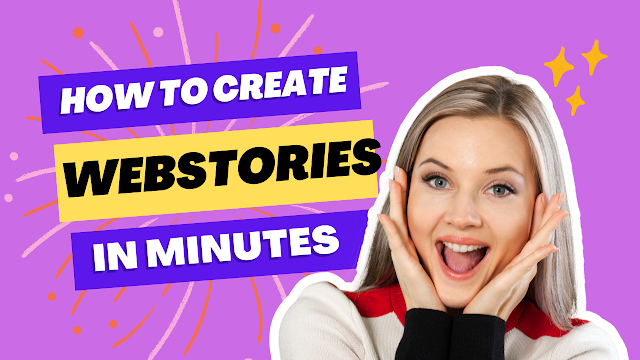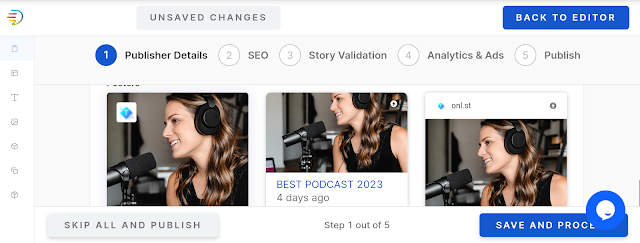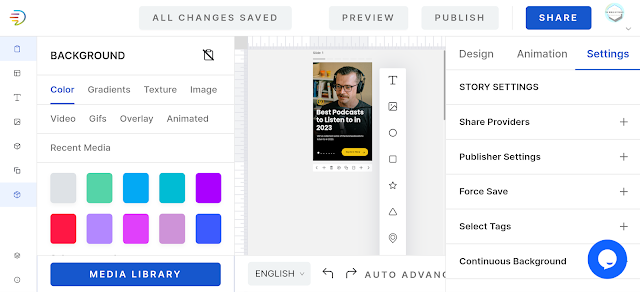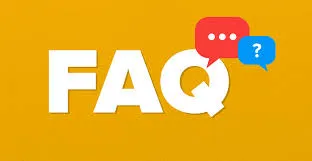How to Create Google Webstories for Blogger Introduction
If you're a blogger looking to create engaging and dynamic content, you've probably heard of Google webstories. These visual stories allow you to share your content in a visually stunning and interactive way. In this blog post, we'll cover everything you need to know about creating Google webstories for your blog. From understanding what webstories are to optimizing them for search engines, we'll give you the tools you need to create stunning webstories and grow your audience.
Brief Overview of Google Webstories
Google webstories are a visual storytelling format that allows you to create immersive, full-screen experiences for your readers. Originally known as AMP stories, they're a way to create bite-sized content that captures your readers' attention and keeps them engaged. Webstories can be used to tell a story, showcase a product, or provide information in a creative and engaging way.
Importance of Creating Webstories for Bloggers
With the ever-increasing amount of online content, creating webstories is a great way to separate your blog from the noise. They can be used to generate more traffic, display unique and engaging content, increase user engagement and attract new readers to your site. Additionally, because webstories are visually driven, they have higher engagement rates than other types of content.
Understanding Google Webstories
What are Google Webstories?
Google webstories are a form of visual content that is created entirely within Google's platform. They consist of a series of full-screen pages that allow you to tell a story through a combination of text, images, and animations.
Key Features of Webstories
- Fullscreen experience
- Swipe-based navigation
- Interactive elements
- Visually driven
- Mobile-optimized
- Quick-loading
- Benefits of Using Webstories
- Higher engagement rates
- Increased readership
- Easier to share and distribute
- Can be monetized
- Creating Google Webstories for Blogger
Preparing for Webstory Creation
Before you create your first webstory, there are a few things you need to do to prepare.
Creating a Google Account and Linking it to Your Blog
If you don't already have a Google account, you will need to create one to start using webstories. Once you've created your account, you'll need to link it to your blog so that you can create and publish your webstories.
Choosing the Right Webstory Format
There are a few different webstory formats available, each with its own advantages and disadvantages. Consider your audience and the story you're trying to tell when selecting the right format.
Designing Visually Appealing Webstories
One of the biggest benefits of webstories is the ability to create visually stunning content. To make your webstories stand out, consider incorporating visually interesting elements like bold fonts, eye-catching graphics and interactive elements.
Adding Interactive Elements to Webstories
Interactive elements are a great way to keep your readers engaged throughout your webstory. Consider adding elements like quizzes, polls and interactive graphics to get readers involved in the story.
Writing Engaging Webstory Content
While visual elements are an important part of the webstory creation process, it's important not to overlook the text. Your story should be engaging, informative and well-written.
Determining the Audience for Your Webstories
Before you start writing your webstory, it's important to consider who your target audience is. This will help you tailor your story to their interests and make it more engaging.
Crafting a Compelling Narrative for Your Webstories
Your webstory should have a clear beginning, middle and end. Consider using storytelling techniques like foreshadowing and cliffhangers to keep your readers engaged.
Optimizing Your Webstories for Search Engines
Search engine optimization (SEO) is an important part of the webstory creation process. By optimizing your webstories for search engines, you can increase your visibility and attract more readers.
Conducting Keyword Research for Webstories
Before you start writing your webstory, it's important to do some keyword research to identify the keywords and phrases that your target audience is searching for. Consider incorporating these keywords into your webstory for better SEO.
Writing SEO-Friendly Descriptions and Titles for Webstories
Your webstory's title and description are the first things readers will see, so it's important to make them both attention-grabbing and SEO-friendly.
Optimizing Webstory URLs and Metadata
Optimizing your webstory's URL and metadata can help improve your search engine rankings. Consider including relevant keywords and descriptive tags to make your content more discoverable.
Sharing Webstories on Social Media and Other Channels
Once you've created your webstory, it's important to share it with your audience. You can do this by sharing it on social media or incorporating it into your email newsletter.
Measuring the Success of Your Webstories
To determine the effectiveness of your webstories, it's important to track their performance over time.
Defining Metrics to Measure Webstory Performance
Consider tracking metrics like page views, engagement rates and time on page to evaluate the success of your webstory.
Using Google Analytics to Track Webstory Views and Engagement
Google Analytics is a powerful tool that can help you track the performance of your webstories. Consider setting up custom dashboards to monitor your metrics and gain valuable insights into your readers' behavior.
Making Data-Driven Decisions to Improve Webstory Performance
By analyzing your webstory's performance data, you can make data-driven decisions to improve your content and drive more engagement.
How To Create Webstories For Blogger Using Make Makestories
Step 1: Find a Web Story Creator
Explore online SAAS products like MakeStories, which provide end-to-end solutions for web story creation.
Consider features such as drag and drop functionality, team collaboration workspace, WordPress plug-in integration, and fast and secure web hosting.
Step 2: Outline the Webstory
Create a draft or storyboard to visualize the narrative you want to convey. Structure your story with an eye-catching introduction, main body, and conclusion.
Google provides a simple template to get started.
Step 3: Add Visual Elements
Design high-quality content to capture the user's attention.
Make use of MakeStories' extensive media library, which includes HD images, videos, and GIFs.
Ensure that the chosen visuals fit the vertical, full-page format of web stories.
Step 4: Create the WebStory
Utilize MakeStories' features to make your web stories attractive and interactive.
Consider elements like backgrounds, templates, text, layers, elements, auto animate, and add-ons for interactivity.
Ensure that your web story meets the requirements such as title length, minimum number of pages, text length, alt text for images, and licensing of media assets.
Step 5: Publish the Webstory
- Use the web story creator to publish your web story.
- Set up publisher details, meta tags, and SEO information.
- Validate your story to ensure it meets the necessary requirements.
- Set up analytics to track performance.
- Add your domain or create a dedicated web stories-only site.
Once the web story is created, you can use MakeStories' widgets to display your stories on your webpage or embed them within your own articles using iframe.
In Summary
By following these tips, you can create engaging and visually stunning webstories that will help you grow your audience and drive more traffic to your blog. Whether you're telling a story or promoting a product, webstories are the perfect way to create dynamic and compelling content.
Frequently Asked Questions (FAQs).
What kind of stories can I create with Google webstories?
With Google Webstories, you can create various types of stories such as educational, informational, news-related, lifestyle, and more. The main purpose is to make the content more engaging and interactive for the viewers. You can create dynamic visuals, videos, and animations to enhance the narrative and make it more compelling.
Do I need any coding skills to create webstories?
No, you don't need any coding skills to create webstories. Google has made it easy for anyone to create webstories with a simple drag-and-drop tool that is easy to use. You can customize the design elements such as fonts, backgrounds, and animations without any hassle. The user interface is intuitive and user-friendly, so you can create stories without needing any technical know-how.
How long should my webstories be?
There is no hard and fast rule for the length of webstories, but it is recommended to keep them short and sweet. You should aim for a duration of 10-15 seconds per page, and a maximum of 10 pages. The attention span of the audience is short, so it's crucial to make your story concise and to the point. However, you should balance the length with the content's quality and make sure that your story has a cohesive narrative.
Can I monetize my webstories?
Yes, you can monetize your webstories by using Google AdSense. Once you have created a Google Webstories website, you can apply for Google AdSense to show relevant ads on your webstories. This way, you can earn money when people click on the ads displayed on your webstories. However, it's important to note that the content must comply with Google's policies to qualify for monetization.
Can I collaborate with other bloggers to create webstories?
Yes, you can collaborate with other bloggers to create webstories. This can be a great way to create high-quality content and reach a wider audience. You can split the workload and create different parts of the story, bringing your unique skills and perspectives together. Google Webstories also allows you to add multiple authors to your website, so you can collaborate with your team members easily.




